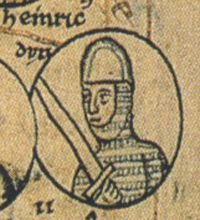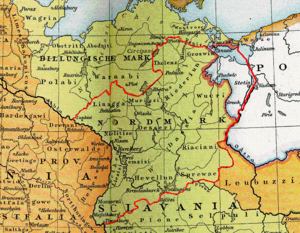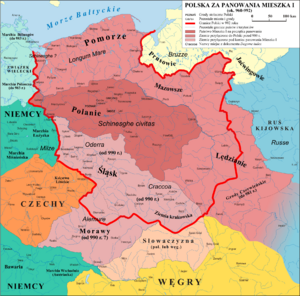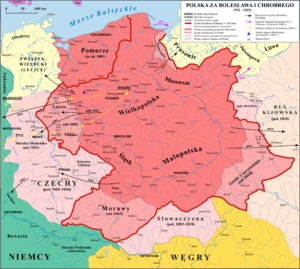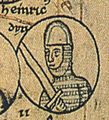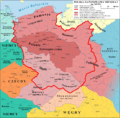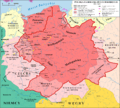Otto III, Holy Roman Emperor facts for kids
Quick facts for kids Otto III |
|
|---|---|
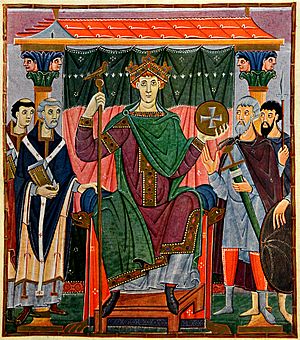
Otto III from the Gospels of Otto III
|
|
| Holy Roman Emperor | |
| Reign | 21 May 996 – 23 January 1002 |
| Predecessor | Otto II |
| Successor | Henry II |
| King of Italy | |
| Reign | 12 April 996 – 23 January 1002 |
| Predecessor | Otto II |
| Successor | Arduin of Ivrea |
| King of Germany | |
| Reign | 25 December 983 – 23 January 1002 |
| Coronation | 983 |
| Predecessor | Otto II |
| Successor | Henry II |
| Regent | |
| Born | June/July 980 Klever Reichswald near Kessel, Kingdom of Germany |
| Died | 23 January 1002 (aged 21) Faleria, Papal States |
| Burial | Aachen Cathedral |
| House | Ottonian |
| Father | Otto II, Holy Roman Emperor |
| Mother | Theophanu |
Otto III (born June/July 980 – died January 23, 1002) was a powerful ruler. He was the Holy Roman Emperor from 996 until his death. He belonged to the Ottonian dynasty, a famous family of emperors. Otto III was the only son of Emperor Otto II and his wife Theophanu.
Otto III became King of Germany in 983 when he was only three years old. This happened shortly after his father died in Southern Italy. Because Otto was so young, different regents (people who rule for a child king) held power. His cousin, Henry II, Duke of Bavaria, first tried to rule. He even tried to take the throne for himself in 984. But his rebellion failed. Henry II then had to let Otto III's mother, Theophanu, become regent. She ruled until she died in 991. After her, Otto's grandmother, Adelaide of Italy, was regent until 994.
In 996, Otto III went to Italy to claim the titles of King of Italy and Holy Roman Emperor. These titles had been empty since his father's death. Otto III also wanted to bring the city of Rome back under imperial control. Rome had rebelled under Crescentius II. After being crowned emperor, Otto III stopped the rebellion. He made his cousin Pope Gregory V, who was the first German Pope. When Otto left, Crescentius II rebelled again. He removed Gregory V and put John XVI in charge. Otto III returned in 998, put Gregory V back, and punished Crescentius II and John XVI. When Gregory V died in 999, Otto III chose Sylvester II as the new pope. Otto's actions made the emperor's power over the Catholic Church much stronger.
From the start of his rule, Otto III faced problems from the Slavs in the east. After his father died in 983, the Slavs rebelled. They forced the Empire to give up lands east of the Elbe River. Otto III tried to get these lands back during his reign, but he had limited success. In the east, Otto III made stronger connections with Poland, Bohemia, and Hungary. In 1000, he helped spread Christianity by supporting missionaries in Poland. He also helped crown Stephen I as the first Christian king of Hungary.
In 1001, Otto returned to Rome. But the Roman nobles rebelled again. They forced him to leave the city. While marching to take back Rome in 1002, Otto suddenly got a fever. He died in Castle Paterno at the age of 21. He had no children to take his place. His early death caused a big political problem for the Empire.
People have different ideas about Otto III. Some saw him as a brilliant and religious leader. Later, some historians thought he was a dreamer who didn't focus enough on Germany. Today, many historians see him in a good way. But some parts of his rule, like his plan to restore the Roman Empire, are still debated.
Contents
Otto III's Early Life and Family
Otto III was born in June or July 980. His birthplace was between Aachen and Nijmegen in modern-day Germany. He was the only son of Emperor Otto II and Empress Theophanu. Otto III was the youngest of their four children. Before Otto III was born, his father had fought wars in France.
In July 982, Otto II's army lost a big battle against the Muslims in Sicily. Otto II wanted to add all of Italy to the Holy Roman Empire. Many important officials died in this battle. After the defeat, Otto II's nobles asked him to do something. At a meeting in Verona in 983, he suggested that his three-year-old son, Otto III, be elected king. This would make Otto III his clear heir apparent. This was the first time a German ruler was elected in Italy.
After the meeting, Otto III traveled to Aachen to be crowned. This was the usual place for German kings to be crowned. Otto II stayed in Italy to fight the Muslims. But Otto II suddenly died on December 7, 983. He was buried in St. Peter's Basilica in Rome.
Otto III was crowned king on Christmas Day 983. This was just three weeks after his father's death. Willigis, the Archbishop of Mainz, and John X, the Archbishop of Ravenna, crowned him. News of Otto II's death reached Germany after his son's coronation. The Empire was in a difficult situation. There were problems in southern Italy and a Slavic uprising in the east. With a child on the throne, the Empire was confused. Otto III's mother, Theophanu, became the regent for her young son.
Ruling as a Child King
Henry II's Time as Regent
Otto III's cousin, Henry II, Duke of Bavaria, had been removed from his title by Otto II in 976. He was put in prison. After Otto II died, Henry was released. Henry II was the closest male relative in the Ottonian dynasty. So, he claimed the right to rule for his young cousin. The Archbishop of Cologne, Warin, agreed to let Henry II be regent. Only Otto III's mother, Theophanu, and his grandmother, Adelaide of Italy, disagreed. But they were in Italy and could not stop him.
Henry II acted more like he wanted the throne for himself than just being a guardian. He tried to make alliances with other important people. He even made a deal with King Lothar of France. Henry II promised to give Lothar some land if Lothar helped him become king of Germany. But Henry changed his mind at the last minute.
Henry II took the young Otto III to Saxony. There, Henry II invited all the important nobles to a big celebration. He openly tried to get support for his claim to the German throne. Some people supported him, like Duke Mieszko I of Poland and Duke Boleslaus II of Bohemia.
But many nobles opposed Henry II. They went to Quedlinburg in Saxony to plan against him. Henry II moved his army there to stop them. But the negotiations failed. The nobles refused to promise loyalty to anyone but Otto III. Bernard I, Duke of Saxony, especially stayed loyal to the child king. Henry II then promised more peace talks and went to Bavaria. Many leaders there recognized him as the rightful heir. But Henry III, Duke of Bavaria, who Otto II had put in charge, stayed loyal to Otto III.
Henry II's plan to become king depended on getting support in Duchy of Franconia. The Franconian nobles, led by Archbishop Willigis of Mainz, refused to abandon Otto III. Fearing a civil war, Henry II gave Otto III back to his mother and grandmother on June 29, 985. In return, Henry II got his title as Duke of Bavaria back.
Theophanu's Time as Regent
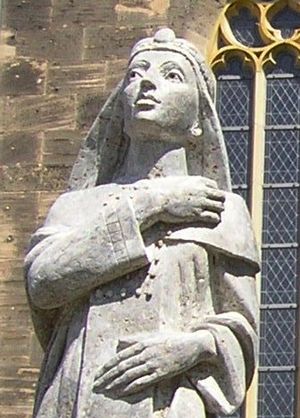
Theophanu ruled as regent from 984 until her death in 991. Her time as regent was mostly peaceful without internal rebellions. She worked to bring back the Diocese of Merseburg, which her husband Otto II had changed. Theophanu kept Otto II's trusted advisors, like Count Bernward of Hildesheim and Archbishop Willigis. Willigis had a lot of power in running the kingdom. One of Theophanu's biggest successes was keeping German control over Bohemia. Boleslaus II, Duke of Bohemia, had to accept Otto III's authority.
In 986, the five-year-old Otto III celebrated Easter in Quedlinburg. The four main dukes of Germany showed their respect to the child king. They served Otto III in special roles, showing their loyalty. This was very important because Henry II, who had rebelled, also showed his loyalty. From age six, Otto III was taught by Bernward of Hildesheim and Gerbert d'Aurillac.
During Theophanu's regency, a conflict called the Great Gandersheim Conflict happened. It was about who controlled Gandersheim Abbey. Both the Archbishop of Mainz and the Bishop of Hildesheim claimed authority. The conflict started in 989 when Otto III's older sister, Sophia, became a nun there. Sophia only recognized the Archbishop of Mainz's authority. The conflict became so big that Otto III and Theophanu had to step in. They decided that both bishops would anoint Sophia. But only the Bishop of Hildesheim would anoint the other nuns.
In 989, Theophanu and Otto III went to Italy to visit Otto II's grave in Rome. After crossing the Alps, Theophanu had her friend John Philagathos made Archbishop of Piacenza. After a year in Italy, the royal court returned to Germany. Theophanu died in Nijmegen on June 15, 991, at age 31. She was buried in the Church of St. Pantaleon in Cologne.
Otto III was still a child, only eleven years old, when his mother died. So, his grandmother, Adelaide of Italy, became regent. She ruled with Archbishop Willigis of Mainz until Otto was old enough to rule alone in 994.
Otto III Becomes Independent
As Otto III grew older, his grandmother's power slowly decreased. In 994, Otto III turned 14. At a meeting in Solingen in September 994, Otto III was given full power to rule the kingdom without a regent. After this, Adelaide retired to a nunnery she had started. She spent her remaining days serving the Church. Since Otto III was not married, his older sister Sophia acted as his royal companion from 995 to 997.
One of Otto III's first acts as an independent ruler was to appoint Heribert of Cologne as his chief official for Italy. Otto III followed his grandfather Otto I's example. He appointed a new pope, Gregory V, and then left Rome. But Gregory V was later removed. So Otto III returned to Rome in 998 and stayed there until his death. In 995, Otto sent John Philagathos to Constantinople. He wanted to arrange a marriage for himself with a Byzantine princess. This was like his father, Otto II, who married the Byzantine Theophanu. They discussed marrying Zoe Porphyrogenita.
Fighting the Slavs
The Lutici tribes, a group of West Slavic people, were quiet during Otto III's early rule. But in 983, after Otto II's defeat, the Slavs rebelled. They forced the Empire to give up its lands east of the Elbe River. This stopped the spread of Christianity there. Theophanu launched many campaigns to get these eastern lands back, starting in 985. Even though he was only six, Otto III took part in these campaigns. In 986, Otto III received respect from Duke Mieszko I of Poland. Mieszko I helped the imperial army and gave Otto III a camel. The Lutici were controlled for a while, but they kept causing problems for the young king.
In September 991, when Otto III was eleven, Slavic raiders captured Brandenburg. In 992, this invasion and attacks by Viking raiders forced Otto III to lead his army. He suffered a big defeat. The next year, Germany faced famine and disease. In 994 and 995, Otto III led unsuccessful campaigns against the northern Slavs and Vikings. But he did manage to take back Brandenburg in 993. In 995, he defeated the Obotrite Slavs.
In late 995, after Otto III became an adult, he again fought the Lutici. This time, he was helped by the Polish Duke Bolesław I the Brave. In 997, he had to deal with a new Lutician attack on Arneburg on the Elbe River.
Otto III's Reign as Emperor
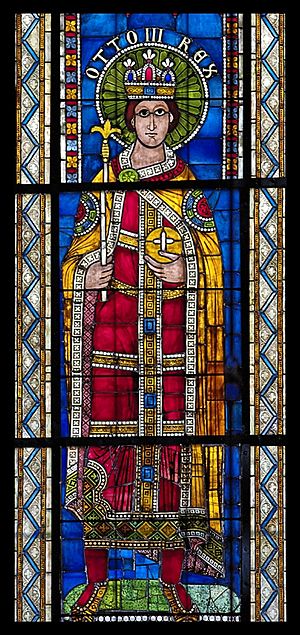
Problems in Rome
Before his death in 983, Otto II had made Pietro Canepanova pope. He was called Pope John XIV. He was not from Rome and had been Otto II's chief official in Italy. After Otto II died, John XIV tried to help in the dispute between Henry II and Theophanu.
During this time, the Roman nobles saw a chance to remove John XIV. They wanted a Roman pope. Antipope Boniface VII, who had been exiled, joined forces with Byzantine nobles. They marched on Rome in April 984 to claim the papal throne. With help from Crescentius the Elder's sons, Crescentius II and John Crescentius, Boniface VII imprisoned John XIV. Four months later, John XIV died in prison. He was likely starved or poisoned by Boniface.
With Otto's regents in Germany, Crescentius II took the title of Patrician of the Romans. He became the real ruler of Rome. When Boniface VII died in 985, Pope John XV was chosen as the next pope. Crescentius II likely played a big part in this choice. For several years, Crescentius II controlled the city, limiting the pope's power. When Empress Theophanu was in Rome, Crescentius II pretended to be under her authority. But he still ruled the city.
First Trip to Italy
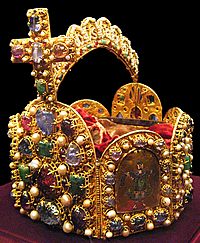
After becoming king in 994, Otto III first dealt with a Slavic rebellion. Then he faced Crescentius II's attempt to take power in Italy.
When Otto III focused on Italy, he wanted to be crowned Emperor. He also wanted to help Pope John XV, who had been forced to leave Rome. Otto left Germany for Italy in March 996. In Verona, he became a supporter of Otto Orseolo. This led to good relations between the Holy Roman Empire and the Republic of Venice.
Otto III reached Pavia for Easter in 996. He was declared King of Italy and crowned. But he did not reach Rome before Pope John XV died. While Otto III was in Pavia, Crescentius II made peace with Otto III. He agreed to accept Otto's choice for pope.
In Ravenna, Otto III chose his cousin Bruno, who was only 23, to be pope. He sent Bruno to Rome with Archbishop Willigis. In May 996, Bruno became Gregory V, the first German pope. Crescentius II had submitted to Otto III, but he hid in his family's castle, the Tomb of Hadrian.
The new pope crowned Otto III as emperor on May 21, 996, in Rome. The Emperor and Pope then held a meeting. Roman nobles who had rebelled were called to explain their actions. Many rebels, including Crescentius II, were sent away. But Pope Gregory V wanted to show mercy. He asked the Emperor for forgiveness for them. Otto III pardoned them. Crescentius II lost his title but was allowed to live in Rome.
After the meeting, Otto III chose Gerbert of Aurillac, the Archbishop of Reims, as his teacher. Otto III wanted to reorganize the Empire. He was inspired by ancient Rome and his Byzantine mother. Otto III dreamed of bringing back the glory of the Roman Empire. He saw himself as the head of a religious state. He also brought in some Byzantine court customs. To make his power stronger in Italy, Otto III sought support from religious groups.
By choosing Gregory V, Otto III had more control over the Church than his grandfather Otto I. Otto I could only reject papal candidates. But Otto III had chosen and installed his own candidate. The Emperor also refused to accept the Donation of Constantine. This was a document that supposedly gave the Pope secular power over western Europe. Otto III said it was fake. These actions caused more tension between the Roman nobles and the Church. They usually chose the pope from their own members.
After his coronation, Otto III returned to Germany in December 996. He stayed there until April 997. In summer 997, Otto III fought against the Elbe Slavs. He wanted to protect Saxony's eastern border.
Second Trip to Italy
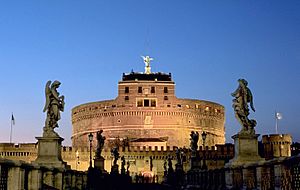
When Otto III left Italy, Rome was still unstable. In September 996, Crescentius II met with John Philagathos. They planned to remove Pope Gregory V. In 997, with help from Byzantine Emperor Basil II, Crescentius II led a revolt. He removed Gregory V and made John Philagathos Pope John XVI in April 997. Gregory fled to Pavia. He held a meeting and excommunicated John.
Otto III put down the Slavic forces in Saxony. Then he began his second trip to Italy in December 997. His sister Sophia went with him. Otto III made his aunt Matilda, Abbess of Quedlinburg, his regent in Germany. Otto III peacefully took back Rome in February 998. The Roman nobles agreed to a peace deal. With Otto III in control, Gregory V was put back as pope. John XVI ran away, but Otto's troops caught him. They brought him before Otto III and Gregory V. Otto III spared John XVI's life and sent him to a monastery in Germany.
Crescentius II again went to the Tomb of Hadrian. Otto III's army attacked it. In late April, the stronghold was broken into. Crescentius II was captured and executed.
Ruling from Rome
Otto III made Rome the main city of his Empire. He brought back old Roman customs and Byzantine court ceremonies. While in Italy, the Emperor and the Pope tried to reform the Church. Church property that had been taken was returned. Also, after the Bishop of Halberstadt died in 996, Otto III and Pope Gregory V began to bring back the Diocese of Merseburg. Otto I had created this Diocese in 968 to Christianize the Polabian Slavs. But it was destroyed in 983 after Otto II's death.
Otto III planned to build his imperial palace on the Palatine Hill. He also wanted to bring back the ancient Roman Senate. He brought back the city's old government system. This included appointing a City Patrician, a City Prefect, and judges. He told them to follow only Roman law. To strengthen his claim to the Roman Empire, Otto III took new titles. He called himself "the Servant of Jesus Christ," "the Servant of the Apostles", "Consul of the Senate and People of Rome," and "Emperor of the World".
Between 998 and 1000, Otto III went on several religious journeys. In 999, he went from Gargano to Benevento. There, he met with a monk named Romuald and Abbot Nilus the Younger. He wanted to make up for executing Crescentius II after promising him safety. During this trip, his cousin Pope Gregory V died in Rome. Otto III then made his old teacher Gerbert of Aurillac Pope Sylvester II. This name was important. It reminded people of the first Pope Sylvester, who supposedly created the "Christian Empire" with Emperor Constantine the Great. This was part of Otto III's plan to connect himself with both the Roman Empire and the Church.
Like his grandfather, Otto III wanted to be like Charlemagne. In 1000, he visited Charlemagne's tomb in Aachen. He took relics from it and brought them to Rome. Otto III also brought back parts of Bishop Adalbert of Prague's body. He put them in the church of San Bartolomeo all'Isola in Rome. Otto III also added the skin of Saint Bartholomew to the relics there.
Relations with Eastern Europe
Poland and the Empire
Around 960, the Polish Piast dynasty under Mieszko I expanded the Duchy of Poland. This brought them into conflict with Germany. Otto I sent his trusted general, Gero, to deal with the Polish threat. Gero defeated Mieszko I in 963. Mieszko I had to recognize Otto I as his overlord. In return, Otto I called Mieszko I "Friend of the Emperor" and "Duke of Poland."
Mieszko I remained a strong ally of Otto I. He strengthened his alliance by marrying into German noble families. Mieszko I, who was not Christian yet, married Dobrawa, a Christian princess from Bohemia, in 965. He then converted to Christianity in 966. This brought Poland closer to Christian states. After Otto I died in 973, Mieszko I supported Henry II against Otto II. When Henry's rebellion failed, Mieszko I swore loyalty to Otto II. When Otto II died in 983, Mieszko I again supported Henry II. But Henry's rebellion failed again, and Mieszko I swore loyalty to Otto III.
Mieszko I's son, Bolesław I, became Duke in 992. Poland continued its alliance with the Empire. Polish forces helped the Empire fight the Great Slav Rising.
Bohemia and the Empire
Germany and the Duchy of Bohemia first had major contact in 929. German King Henry I invaded Bohemia to force Duke Wenceslaus I to pay tribute. When Wenceslaus I was killed in 935, his brother Boleslaus I became Duke. He refused to pay tribute. This led to Otto I, Henry I's son, invading Bohemia. After some fighting, Otto I and Boleslaus I signed a peace treaty in 950. Boleslaus I agreed to pay tribute and recognize Otto I as his overlord. Bohemia then became part of the Holy Roman Empire.
Bohemia was important in the battles along the Empire's eastern border. Boleslaus I helped Otto I defeat Slavs in 953. They also joined forces to defeat the Hungarians in 955. In 973, Otto I created the bishopric of Prague to Christianize the Czech land. To strengthen the alliance, Boleslaus I's daughter Dobrawa married Mieszko I of Poland in 965. This marriage helped bring Christianity to Poland. Boleslaus I died in 972. His oldest son, Boleslaus II, became Duke.
Boleslaus II first sided with Henry II against Otto II in 977. But after Henry's rebellion failed, Boleslaus II swore loyalty to Otto II. When Otto II died in 983, Boleslaus II again supported Henry II. But Henry's attempt failed again, and Boleslaus II swore loyalty to Otto III.
Hungary and the Empire
Otto I's victory over the Hungarians in 955 ended their invasions of Europe. The Hungarian Grand Prince Fajsz was removed after the defeat. Taksony took his place. He tried to keep Hungary separate from the West. His son, Géza, became ruler in 972. Géza sent envoys to Otto I in 973. Géza was baptized in 972, and Christianity spread in Hungary during his rule.
Géza expanded his rule. But many parts of Hungary were still ruled by local leaders. In 997, Géza died. His son, Stephen (originally named Vajk), took over. Stephen was baptized by Bishop Adalbert of Prague. He married Gisela, who was a distant niece of Otto III. Stephen had to fight a rebellion from his relative, Koppány. Stephen defeated Koppány with Western fighting methods and some German knights.
When Otto III went to Poland in 1000, he brought a crown from Pope Sylvester II. With Otto III's approval, Stephen was crowned the first Christian king of Hungary on Christmas Day, 1000.
The Congress of Gniezno
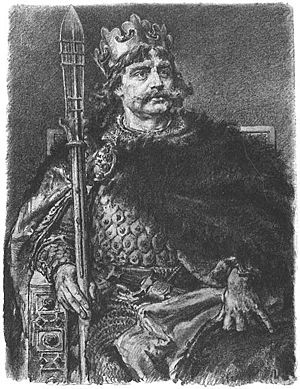
In 996, Duke Bolesław I of Poland sent Bishop Adalbert of Prague to Christianize the Old Prussians. The Prussians killed him in 997. Bolesław I bought Adalbert's body and buried it in the cathedral at Gniezno. This became an important church center in Poland. Otto III and Bolesław I worked together to make Adalbert a saint. He was the first Slavic bishop to become a saint. In December 999, Otto III left Italy to go on a pilgrimage to Gniezno in Poland. He wanted to pray at Adalbert's grave.
Otto III's pilgrimage helped spread Christianity in Eastern Europe. It also strengthened relations with Poland and Hungary. Otto III called them federati ("allies"). At Gniezno, Otto III met Bolesław I. Between March 7 and 15, 1000, Otto III gave Bolesław I important titles. He called him "Brother and Partner of the Empire" and "Friend and ally of Rome." Otto III gave Bolesław a copy of his Holy Lance. Bolesław gave the Emperor a relic, an arm of Saint Adalbert.
During this visit, Otto III made Gniezno an archbishopric. He made Radzim Gaudenty, Adalbert's brother, its first archbishop. Otto III also created three new bishoprics under Gniezno.
Bolesław I then went with Otto III back to Germany. They visited Charlemagne's grave at Aachen Cathedral. They also arranged for Bolesław's son, Mieszko II Lambert, to marry the Emperor's niece, Richeza of Lotharingia.
Otto III's Final Years and Death
Return to Rome
The Emperor spent the rest of 1000 in Italy. In 1001, the people of Tibur rebelled against imperial rule. Otto III easily defeated them. He spared the people of Tibur. This angered the people of Rome, who saw Tibur as a rival. They wanted the city destroyed. Otto III changed his policy towards the papacy. He gave control of Tibur to Pope Sylvester II. It became part of the Papal States, but still under the Holy Roman Empire. Before, Otto III had taken away the Pope's rights as a secular ruler.
Weeks after Otto's actions at Tibur, the Roman people rebelled against him. They were led by Count Gregory I of Tusculum. The rebels surrounded the Emperor in his palace. They forced him to leave the city. Otto, with Bishop Bernward of Hildesheim, returned to negotiate peace. Both sides agreed to a peaceful solution. But mistrust remained. Otto's advisors told him to wait outside the city until more soldiers arrived.
Emperor Otto, with Pope Sylvester II, went to Ravenna. He wanted to do penance and gather his army. In Ravenna, he met with ambassadors from Duke Bolesław I of Poland. He approved King Stephen of Hungary's plans to create the Archdiocese of Esztergom. This would help convert Hungary to Christianity. The Emperor also strengthened ties with the Venetian Doge, Pietro II Orseolo. Otto had been godfather to Pietro II's son, Otto Orseolo. In 1001, he arranged for Pietro II's daughter to be baptized.
Otto III's Death
Otto gathered his army in late 1001. He headed south to Rome to secure his rule. But during the journey, he suddenly got a severe fever. He died in a castle near Civita Castellana on January 24, 1002. He was 21 years old. He had ruled independently for almost six years. The Byzantine princess Zoe, who was supposed to marry him, had just arrived in Italy. Otto III's death has been linked to various causes. Some medieval sources say he caught malaria. Others suggested he was poisoned by Stefania, the widow of Crescentius II.
Otto's body was carried back to Germany by his soldiers. Italians along the route shouted insults at his remains. He was buried in Aachen Cathedral next to Charlemagne.
Who Would Rule Next?
Otto III never married and had no children. So, the Empire had no clear successor. As his funeral procession went through Bavaria in February 1002, Otto III's cousin, Henry IV of Bavaria, asked to be elected king. Most bishops and nobles did not support him. At Otto III's funeral in Aachen, the German nobles again opposed Henry II. Several other candidates wanted the throne. These included Count Ezzo, Margrave Eckard I, and Duke Herman II.
On June 6 or 7, 1002, Henry of Bavaria was elected King of the Romans in Mainz. He was crowned by Willigis. Eckard had already been killed in a separate fight. Henry then fought against Herman of Swabia. But he was recognized by other regions in the following months. On October 1, 1002, Herman finally submitted to Henry II. The fight for the throne was over.
Without an Emperor, Italy began to break away from German control. On February 15, 1002, Arduin, a Lombard noble who opposed the Ottonian dynasty, was elected King of Italy in Pavia.
Otto III's Personality
Otto had a very sharp mind. He was taught carefully by Bernward, who later became a bishop, and Gerbert of Aurillac. He spoke three languages and was so smart that people at the time called him mirabilia mundi, meaning "the wonder of the world." He loved Greek and Roman culture. Some say he once gave a speech where he said he preferred Romans to his German subjects. However, it's not certain if he actually said this.
Images for kids
See also
 In Spanish: Otón III del Sacro Imperio Romano Germánico para niños
In Spanish: Otón III del Sacro Imperio Romano Germánico para niños


